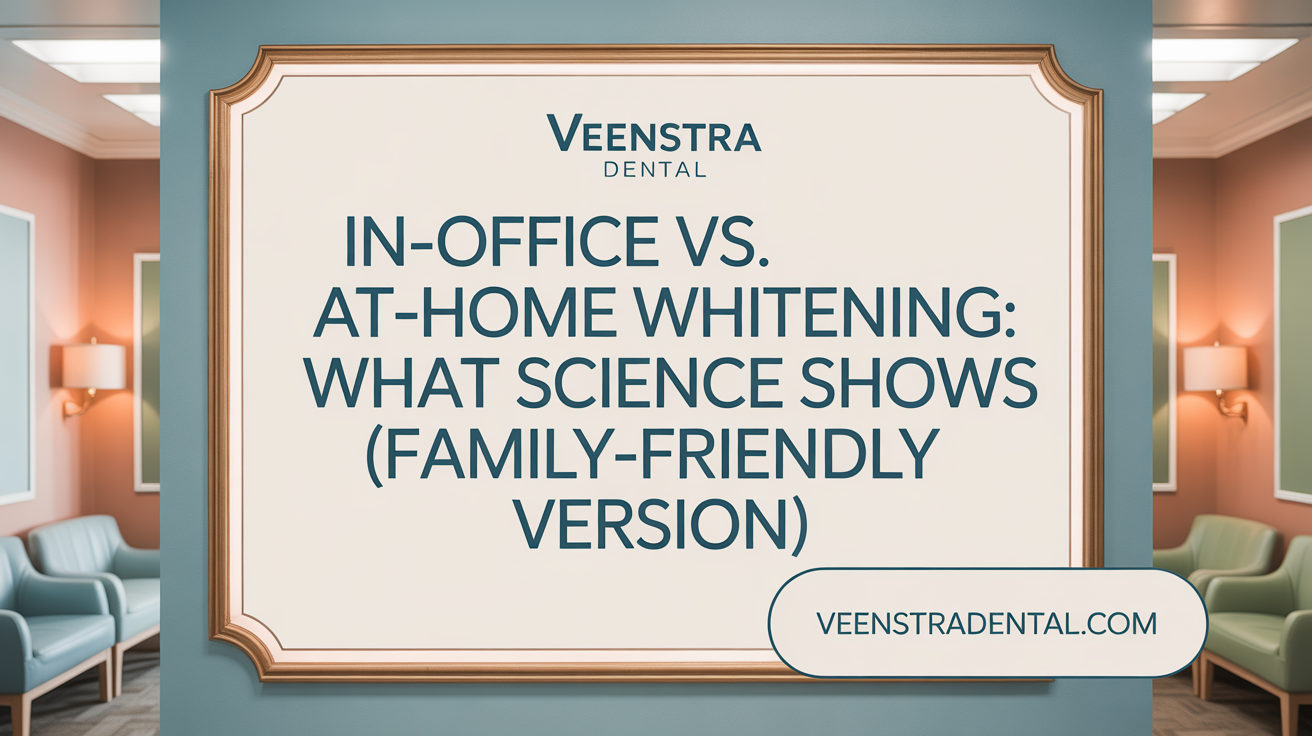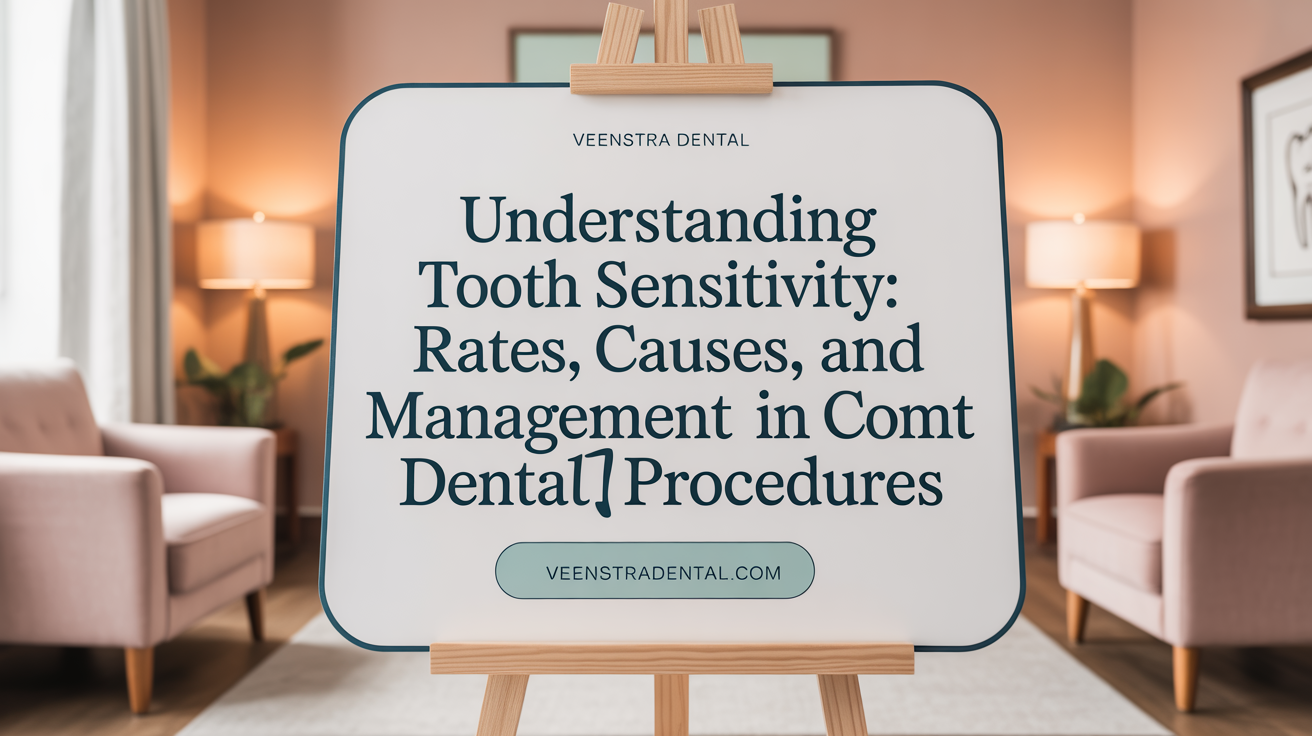Understanding the Science of Professional Teeth Whitening
Professional teeth whitening has become a widely embraced dental cosmetic procedure, promising brighter smiles and enhanced self-confidence. However, patients and dental professionals alike seek clarity on both the effectiveness and safety of such treatments, particularly regarding tooth color improvement and associated sensitivity. This article dives deep into scientifically supported data concerning how well professional whitening works and the rates and management of tooth sensitivity, providing an evidence-based perspective for informed decision-making.
Key Facts on Professional Teeth Whitening and Sensitivity Management
- Professional whitening, whether in-office or at-home, is scientifically validated as effective with minimal side effects, especially when managed properly.
- Approximately 54% of patients report mild sensitivity, with 10% experiencing moderate and 4% severe sensitivity that typically resolves within a few weeks.
- Sensitivity is more common in cases of gum recession and with higher peroxide concentrations, but can be minimized through proper protocols and protective measures.
- Whitening agents like hydrogen peroxide vary in efficacy and side effects; higher concentrations produce faster results but increase sensitivity risks.
- Emerging agents such as PAP and bromelain have demonstrated comparable whitening effects with less sensitivity, offering safer alternatives.
- Long-term stability of whitening effects can last up to 2 years, but lifestyle habits, especially staining foods and smoking, influence relapse rates.
- Professional treatments for sensitive teeth often include lower peroxide levels and desensitizing agents like potassium nitrate or fluoride for better comfort.
- With tailored approaches and proper care, sensitivity during whitening can be effectively managed, enhancing patient satisfaction.
- Successful whitening outcomes are typically 2-4 shade improvements, with success rates around 80% after one year and stabilization up to two years.
- Maintaining results involves regular dental cleanings, lifestyle modifications, and periodic touch-up treatments to counteract relapse and keep teeth bright.
1. Comparing Whitening Effectiveness: In-Office Versus At-Home Professional Treatments

What is the scientific evidence on the effectiveness of professional teeth whitening methods?
Scientific research consistently shows that professional whitening procedures—whether in-office or at-home—are effective for significantly lightening tooth shades. In-office treatments typically use high concentrations of hydrogen peroxide (around 35-40%) applied over short periods, leading to rapid and noticeable results. At-home systems, often using carbamide peroxide at concentrations between 10% and 16%, deliver gradual improvements over days or weeks. Multiple studies confirm that these methods cause minimal and temporary side effects like tooth sensitivity and gum irritation, especially when protocols are correctly followed. The addition of light activation, such as LED or laser, has not demonstrated clear advantages in increasing whitening effectiveness or reducing sensitivity. Overall, scientific data supports the efficacy and safety of professionally administered whitening procedures, provided they are managed properly by dental professionals.
2. Tooth Sensitivity in Professional Whitening: Rates, Causes, and Management Strategies

What are the sensitivity rates associated with professional teeth whitening treatments according to scientific data?
Scientific studies show that sensitivity is a common yet manageable side effect when undergoing professional teeth whitening. Approximately 54% of patients report experiencing mild sensitivity. Moderate sensitivity affects about 10% of individuals, while around 4% face severe sensitivity, which can last from one to two weeks. Importantly, sensitivity tends to lessen over time, with no cases of severe sensitivity reported after the second week, and no moderate sensitivity observed after four weeks.
Gingival recession appears to increase the likelihood of experiencing sensitivity during treatment significantly. The type of whitening agent used also impacts sensitivity levels; for instance, lower concentrations of hydrogen peroxide are associated with less discomfort without compromising whitening efficacy. Overall, patient experiences vary, but careful management and appropriate treatment protocols help minimize adverse effects.
What is known about the safety profile and potential side effects of professional teeth whitening?
When conducted under professional supervision, teeth whitening is considered a safe procedure. Dentists ensure the correct application of bleaching agents and employ protective measures, which reduces risks. Typical side effects include temporary tooth sensitivity and mild gum irritation, both of which usually resolve quickly after treatment.
Risks increase with overuse or improper application of whitening agents, potentially damaging the enamel, increasing sensitivity, or altering the enamel surface. To prevent these issues, pre-treatment assessments are essential, along with protective barriers like gum shields and adherence to post-treatment care instructions.
Long-term adverse effects are rare, but aggressive or frequent treatments can cause enamel erosion and increased sensitivity. Patients with pre-existing sensitive teeth, gum disease, or worn enamel are advised to consult their dentist beforehand. Proper protocols and cautious application are crucial to maintaining oral health while achieving desired whitening results.
Is there evidence supporting whitening treatments designed for sensitive teeth and strategies to manage sensitivity?
Indeed, specific whitening products formulated for sensitive teeth contain lower levels of peroxide combined with desensitizing agents such as potassium nitrate or fluoride. These products aim to balance effective whitening with reduced discomfort.
Pre- and post-treatment strategies are vital to managing sensitivity. Using desensitizing toothpaste, gels, and fluoride treatments before whitening can build resistance to sensitivity. Applying desensitizing agents during and after treatment further minimizes discomfort.
Professional treatments tailored for sensitive patients include options like laser whitening, custom-fitted trays with lower peroxide concentrations, and dentist-supervised at-home kits. Patients are advised to avoid hot or cold foods and beverages post-treatment and to continue using desensitizing products as recommended.
Overall, with proper patient education, careful product selection, and controlled application protocols, individuals with sensitive teeth can safely undergo whitening procedures and achieve satisfying aesthetic outcomes.
Scientific Evidence on the Effectiveness of Professional Teeth Whitening Methods
What is the scientific evidence on the effectiveness of professional teeth whitening methods?
Research consistently shows that professional teeth whitening techniques—whether in-office, at-home, or combined approaches—are effective at significantly improving tooth appearance. In-office treatments typically use high concentrations of hydrogen peroxide (around 35-40%), applied over short periods of 15-20 minutes, leading to rapid and noticeable whitening results. These methods have been validated by clinical trials, which demonstrate that patients experience an average improvement of 2 to 4 shade guide units, with results visible immediately after treatment.
At-home whitening procedures, often involving lower peroxide concentrations such as 10-16% carbamide peroxide, are equally effective in the long run. Studies reveal that the color change achieved with at-home kits can be comparable to in-office treatments when used over recommended durations, often several days or weeks. Notably, long-term studies indicate that whitening effects can be stable for up to two years, with some degree of relapse depending on patient habits like diet and oral hygiene.
Clinical trials have also examined the impact of protocol modifications, such as shortening in-office application times, and found no significant difference in whitening efficacy or sensitivity outcomes. For example, reducing application sessions from 7 days to 2 days did not compromise results or increase discomfort. These findings emphasize that efficient protocols tailored to patient needs can maintain high success rates.
Overall, scientific evidence supports that both professional in-office and supervised at-home whitening methods are safe and effective, delivering measurable aesthetic improvements. When properly managed by dental professionals, these treatments pose minimal risk for long-term damage to enamel or oral tissues, making tooth whitening a reliable option for enhancing dental esthetics.
Outcomes, Efficacy, and Success Rates of Professional Teeth Whitening

What are the typical outcomes, efficacy, and success rates of professional teeth whitening procedures?
Professional teeth whitening procedures are known for their high success rates and patient satisfaction. Most treatments lead to a visible improvement in tooth color, often with a whitening effect of about 2 to 4 shades guide units. Both in-office bleaching and dentist-supervised at-home systems have been shown to be effective in adjusting tooth shade, with outcomes generally comparable.
Studies indicate that approximately 80% of non-vital teeth whitening treatments are successful after one year, with effectiveness decreasing to around 45% after six years. The results are usually stable for up to two years, with some minor relapse depending on factors like diet, oral hygiene, and habits such as smoking.
Patient satisfaction tends to be high across different whitening methods. People appreciate the noticeable improvements in smile aesthetics, although some report increased tooth sensitivity which can affect comfort temporarily.
The success of whitening largely hinges on the bleaching agent’s concentration and duration of exposure. Higher concentrations of hydrogen peroxide used in in-office procedures provide greater initial whitening but have a slightly higher risk for sensitivity and relapse within six months. Conversely, at-home treatments with carbamide peroxide at lower concentrations (10-16%) tend to yield effective long-term results, with fewer adverse effects.
Long-term follow-up studies confirm that whitening effects can last up to two years, but maintaining results depends heavily on lifestyle choices such as avoiding stain-causing foods and maintaining good oral hygiene. Regular dental check-ups and touch-up treatments can prolong the benefits.
Patient satisfaction and self-perception
Patients generally report positive perceptions of their smile after whitening. The psychological impact of improved smile aesthetics often boosts self-confidence. Despite this, some individuals experience discomfort due to sensitivity, which can be managed with appropriate products and procedures.
Long-term stability and relapse
While the initial results are promising, some gentle regression of whitening results can occur over time, especially if patients continue habits that stain teeth. Many studies show that conventional whitening procedures maintain color stability for up to 6 months, with some groups displaying a slight improvement or stabilization later.
The relapse can be mitigated by avoiding staining foods and beverages, using desensitizing products, and following-up treatments as recommended by dental professionals.
| Aspect | Typical Outcome | Timeframe | Notes |
|---|---|---|---|
| Success Rate in Vital Teeth | ~80% after 1 year | Up to a year | Effectiveness reduces slightly over years |
| Stability Duration | Up to 2 years | Long-term | Subject to individual habits |
| Relapse Rate | Varies | Within 6 months | Influenced by lifestyle |
| Patient Satisfaction | High | Post-treatment | Can be affected by sensitivity |
Overall, professional teeth whitening offers a reliable and effective way to enhance smile aesthetics, with outcomes that satisfy most patients when protocols are correctly followed.
Safety Profile and Potential Side Effects of Professional Teeth Whitening
What is known about the safety profile and potential side effects of professional teeth whitening?
Professional teeth whitening, when carried out by a qualified dentist, is generally considered a safe dental procedure. The supervision ensures proper application, monitoring, and immediate management of any adverse reactions. Most patients experience only mild and temporary side effects.
A common side effect is tooth sensitivity, which can occur during or after whitening sessions. This sensitivity is typically transient, lasting only a few days, and often subsides on its own. Gum irritation is another possible side effect, usually resulting from gel contact with soft tissues, but it is generally mild and resolves quickly once treatment is completed.
Surface integrity of the enamel is usually unaffected when guidelines are followed. However, overuse of bleaching agents, high peroxide concentrations, or improper application can potentially lead to enamel demineralization, increased porosity, or surface erosion, which may enhance sensitivity and risk of future dental issues.
To minimize risks, dentists take several precautions. These include conducting pre-treatment assessments to evaluate the condition of the patient's teeth and gums, protecting soft tissues with rubber dams or shields, and selecting appropriate peroxide concentrations. Post-treatment care, such as avoiding stain-causing foods and maintaining good oral hygiene, can help ensure long-lasting results.
While long-term adverse effects are rare, exceeding recommended treatment durations or frequency can pose risks. Patients with existing conditions like sensitive teeth, gum disease, or enamel wear should seek professional advice first. Customized treatment plans help optimize safety and efficacy.
In summary, professional teeth whitening is safe when protocols are followed. Proper patient selection, careful application, and adherence to recommended guidelines are essential to prevent complications and achieve desirable results. Patients should always discuss their medical and dental history with their dentist prior to whitening procedures to determine suitability and safety.
Sensitivity Rates Associated With Professional Teeth Whitening Treatments

What are the sensitivity rates associated with professional teeth whitening treatments according to scientific data?
Scientific research shows that tooth sensitivity is a frequent side effect of professional whitening procedures. Data indicates that around 54% of patients report experiencing mild sensitivity during and after treatment.
In more concerning cases, about 10% of patients experience moderate sensitivity, which can be uncomfortable but generally transient. Severe sensitivity is less common, affecting roughly 4% of patients, with symptoms lasting from one to two weeks.
Most patients find that sensitivity diminishes over time. By the second week post-treatment, severe cases tend to resolve completely, and no moderate sensitivity is usually observed after four weeks.
Factors Influencing Sensitivity During Whitening
Several factors impact the intensity and duration of sensitivity experienced during professional whitening. One significant factor is the presence of gum recession, which exposes root surfaces and increases sensitivity.
The type and concentration of whitening agents also play a crucial role. Higher concentrations of hydrogen peroxide, often used in in-office treatments, can lead to increased sensitivity.
Conversely, lower peroxide concentrations tend to cause less discomfort while still delivering effective whitening, making them a preferred choice for sensitive teeth.
Application techniques, treatment duration, and interval between sessions influence sensitivity as well. Shorter application times and appropriate spacing between sessions can help minimize adverse effects.
Duration, Recovery, and Management of Sensitivity
Most sensitivity associated with whitening is transient, typically lasting only a few days post-treatment. Patients are advised to use desensitizing toothpaste and avoid overly hot, cold, or acidic foods during recovery.
In cases of persistent discomfort, dentists might recommend desensitizing agents or suggest adjusting future whitening protocols.
Long-term studies reveal that sensitivity generally decreases with time, and careful management can further reduce discomfort, making whitening a viable and relatively comfortable cosmetic procedure.
| Aspect | Data & Insights | Additional Notes |
|---|---|---|
| Incidence | ~54% mild, ~10% moderate, ~4% severe | Varies with agents and individual factors |
| Severity | Lasts up to 2 weeks for severe cases | Usually diminishes without intervention |
| Influencing Factors | Recession, peroxide concentration, application duration | Proper technique reduces sensitivity |
| Recovery | Usually within days, with management | Use of desensitizers recommended |
| Long-term Effect | Sensitivity wanes over weeks, no lasting effects | Ensuring proper protocol can prevent prolonged discomfort |
Overall, understanding the individual risk factors and employing appropriate techniques can help manage sensitivity effectively, ensuring patients enjoy the benefits of whitening with minimal discomfort.
Relapse Rates Following Teeth Whitening Procedures

What does research indicate about relapse rates following teeth whitening procedures?
Studies show that the effects of teeth whitening can last for about two years, though some variations exist based on individual circumstances. Long-term follow-ups demonstrate that many patients retain a significant portion of their initial whitening. For example, carbamide peroxide treatments often retain more than 65% of their whitening effect after approximately 4.5 years, especially when combined with good oral hygiene practices.
Short-term relapse is most common within the first 24 hours post-treatment, mainly due to the temporary nature of some bleaching effects. Over the subsequent years, some degree of color rebound occurs, influenced by a variety of factors. The success rate for non-vital bleaching remains quite high at around 80% after one year but drops significantly to about 45% after six years, showing ongoing discoloration over time.
Several factors can accelerate relapse, including dietary habits and lifestyle choices. Consumption of stain-causing foods and beverages such as red wine, coffee, tea, and cola contribute significantly to re-darkening of the teeth. Smoking also plays a considerable role, as tobacco products deposit stains on enamel surfaces.
To maintain whitening results for as long as possible, dentists recommend consistent oral hygiene routines and periodic top-up treatments. While these measures can prolong the aesthetic benefits, individual variation makes exact timelines unpredictable. Some patients may need re-treatment every 4 to 6 years, especially when exposed regularly to staining agents.
In summary, while teeth whitening offers durable results, maintaining that brightness requires ongoing effort and lifestyle adjustments. Being aware of personal risk factors and adhering to professional advice can significantly influence how long whitening results last.
Factors Influencing Whitening Relapse
| Factor | Impact | Additional Notes |
|---|---|---|
| Dietary Habits | Accelerates staining | Coffee, tea, red wine, cola, sauces |
| Tobacco Use | Causes surface stains | Cigarettes, cigars, smokeless tobacco |
| Oral Hygiene | Better hygiene prolongs results | Regular brushing, flossing, professional cleanings |
| Age | Increased age may lead to more staining | Enamel becomes more porous over time |
| Initial Treatment Intensity | Higher concentration may cause quick relapse | Overuse can also lead to sensitivity |
Maintenance Recommendations
| Strategy | Description | Expected Benefit | |------------------------------|----------------------------------------------------------------|------------------------------------------------|| | Regular Dental Cleanings | Biannual professional cleanings | Removes plaque and surface stains | | Lifestyle Changes | Reducing stain-causing foods and quitting smoking | Slows down re-staining | | Use of Whitening Toothpaste| Contains mild abrasives and fluoride | Helps maintain brightness, prevents staining | | Periodic Re-Treatments | Dentist-recommended touch-up procedures | Restores whiteness at regular intervals | | Improved Oral Hygiene | Brushing and flossing after meals | Keeps surfaces clean and less prone to build-up |
Incorporating these habits and scheduling regular check-ups can help extend the benefits of whitening and keep teeth looking brighter for longer.
Comparative Analysis of Whitening Agents and Their Impact on Efficacy and Sensitivity
How do different whitening agents, such as hydrogen peroxide, compare in terms of efficacy and sensitivity impact?
Hydrogen peroxide is widely regarded as the most effective whitening agent used in both in-office and at-home treatments. Its ability to penetrate enamel and dentin allows it to break down complex stains effectively, resulting in noticeable whitening of the teeth. Higher concentrations, such as those used in professional in-office treatments (35-40%), can induce rapid and significant color changes, often improving shade guides by several units. These higher doses can also cause transient tooth sensitivity, affecting nearly 40% of users, with some experiencing discomfort lasting a few days.
However, this increased efficacy comes with a downside. Hydrogen peroxide at high concentrations can cause micro-etching of the enamel surface, leading to increased porosity and potential surface damage. Microscopy and microhardness tests have shown that enamel integrity remains largely intact when proper protocols are followed, but overuse or high concentrations carry risks.
In comparison, alternative agents such as phytopharmaceutical compounds like phthalimidoperoxycaproic acid (PAP) have gained attention. Studies demonstrate that PAP can achieve comparable whitening results, often around an eight-shade improvement after multiple sessions. Importantly, PAP applications tend to produce considerably less sensitivity, with fewer reports of transient discomfort. Enamel surface analysis through microscopy has confirmed minimal surface changes, and microhardness measurements typically show negligible effects, emphasizing its safety for sensitive teeth.
Natural enzymes like bromelain—extracted from pineapple—are also utilized in some whitening products. Bromelain relies on enzymatic breakdown of stains and is considered non-cytotoxic. Although it is gentler and less likely to cause sensitivity, its whitening efficacy is modest compared to peroxide-based agents, often providing subtle improvements rather than dramatic changes.
Efficacy and side effects comparison
| Agent | Whitening Effectiveness | Sensitivity Risk | Enamel Impact | Suitability |
|---|---|---|---|---|
| Hydrogen Peroxide (35-40%) | High; rapid, noticeable shade change | Higher; 40% experience mild to moderate sensitivity | Possible micro-etching, increased porosity | Suitable for quick results, but with caution |
| Phthalimidoperoxycaproic acid (PAP) | Moderate to high; comparable to peroxide | Minimal; low sensitivity | Minimal surface disruption, stable enamel | Ideal for sensitive teeth needing safety |
| Bromelain | Mild; subtle whitening effect | Very low; rare sensitivity | No significant enamel damage | Good for mild whitening, safety priority |
Clinical trial results on new agents
Recent clinical studies have explored the efficacy of alternative whitening agents like PAP and bromelain. One trial involving 40 patients aged 18-65 tested a combined in-office and at-home approach with different peroxide concentrations and alternative agents.
Participants underwent a standard in-office bleaching with 35% hydrogen peroxide, followed by various at-home protocols with lower peroxide concentrations (2-7 days of treatment). The results showed all groups achieved significant whitening, with an average improvement of about 6 shades. Notably, no statistically significant difference was observed between high-concentration peroxide groups and those using PAP or bromelain.
Sensory evaluations indicated similar discomfort levels across groups, with only around 10-15% reporting mild sensitivity, which lasted a few days. Enamel surface analysis via microscopy post-treatment revealed negligible changes in surface morphology for PAP and bromelain, contrasting with some micro-etching seen in high-peroxide treatments.
These findings support the potential of non-peroxide agents like PAP and bromelain as safer alternatives that still deliver effective whitening results, especially for patients with an increased risk of sensitivity or enamel concerns.
In conclusion, while hydrogen peroxide remains the most potent in achieving rapid and significant whitening, emerging agents such as PAP and bromelain offer promising substitutes with favorable safety profiles. The choice of agent should consider individual patient needs, with sensitivity and enamel health as important factors.
Evidence-Based Strategies for Whitening in Sensitive Teeth and Sensitivity Management
Is there evidence supporting whitening treatments designed for sensitive teeth and strategies to manage sensitivity?
There is substantial evidence indicating that specialized whitening options and sensitivity management strategies can effectively help individuals with sensitive teeth. For patients who experience discomfort during whitening procedures, dentists often recommend products formulated for sensitive teeth, which contain lower concentrations of peroxide, typically at 10-16%, and include desensitizing agents such as potassium nitrate or fluoride.
Clinical studies show that pre-treatment with desensitizing agents, like desensitizing toothpaste or gels, can significantly reduce sensitivity during and after whitening procedures. Additionally, advising patients to avoid hot, cold, or sugary foods post-treatment, and continuing the use of sensitivity-reducing products, contributes to better comfort and results.
Professional whitening treatments specifically designed for sensitive teeth often involve methods such as laser whitening with controlled peroxide application, custom-fitted trays with desensitizing gel, or dentist-supervised at home kits containing lower peroxide levels. These approaches are designed to minimize pulp irritation while achieving desirable whitening outcomes.
Recent research confirms that reducing the concentration of peroxide and extending the application duration with lower concentrations can produce comparable whitening results to higher-concentration treatments but with less discomfort.
Patients with sensitive teeth benefit from carefully tailored treatment plans, including the use of desensitizing agents both before and after whitening. These measures not only help manage sensitivity but also enhance overall patient satisfaction.
Overall, the combination of appropriate whitening products, pre- and post-treatment care, and professional guidance allows individuals with sensitive teeth to safely pursue whitening procedures without significant discomfort.
Final Insights on Professional Teeth Whitening Efficacy and Sensitivity
Scientific research consistently shows that professional teeth whitening is an effective and safe cosmetic dental procedure when performed under professional supervision. Both in-office and at-home professional whitening methods offer significant improvements in tooth color, often lasting up to two years, with relapse rates varying by individual factors. The most common side effect is tooth sensitivity, typically mild and transient, with rates influenced by the peroxide concentration used and predisposing patient factors. Innovations in whitening agents and tailored treatments for sensitive teeth provide effective alternatives that reduce discomfort without sacrificing efficacy. Proper patient education, adherence to protocols, and professional guidance remain key to achieving optimal whitening results with minimal adverse effects. This evidence-based understanding can help patients and clinicians make informed choices for bright, confident smiles.
References
- Evaluation of the Effectiveness of Different Types of Professional ...
- Treatment Durations and Whitening Outcomes of Different Tooth ...
- Tooth whitening procedures: A narrative review - ScienceDirect.com
- Evaluating the efficiency of two different over-the-counter tooth ...
- In-office bleaching with a two- and seven-day intervals between ...
- Whitening | American Dental Association
- Best Teeth Whitening Options for People With Sensitive Teeth
